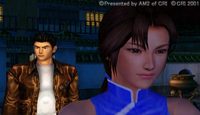|
|

|
PLATFORM
|
Dreamcast
|
BATTLE SYSTEM
|

|
INTERACTION
|

|
ORIGINALITY
|

|
STORY
|

|
MUSIC & SOUND
|

|
VISUALS
|

|
CHALLENGE
|
Easy
|
COMPLETION TIME
|
20-40 Hours
|
|
OVERALL

|
+ Detailed, well-realized locations
+ Investing and memorable sequences
+ Story picks up with perseverance
- Tedium in large measure
- Pacing needs work
- Unresolved cliffhanger
|
Click here for scoring definitions
|
|
|
I remember February 23, 1987 surprisingly well. It was my father's birthday, and he was taking me to preschool when his van died in the middle of rush hour traffic, forcing my mother to get me after he pushed the thing along for a while to the tune of some words I didn't recognize yet. Aside from being the date on which Shenmue II starts, this story has nothing to do with the game, but it nevertheless jogged a memory in me. Ryo Hazuki's continuing quest to track down the killer of his father has its share of exciting moments, and plenty of menial monotony to balance them, but the highs are enough to elevate it a bit above its predecessor.
Yu Suzuki originally intended the story of Shenmue to encompass sixteen games, but the underwhelming sales of the first force a scaling back of that. The second game skips the planned second part of Ryo traveling by boat to Hong Kong, and picks up once he arrives there. He's searching for someone named Yuanda Zhu with information about his father's killer, but finding this fellow proves a time-consuming task. Ryo meets interesting people and experiences the flavor of Hong Kong, but little story progression occurs until he enters the walled city of Kowloon, where he frequently teams with a money-loving mercenary named Ren. There Ryo must first find Zhu, and then rescue him from a dangerous group of criminals Ren already rubbed the wrong way in the past.
Interesting story events pick up substantially as the end approaches, and by the time of its cliffhanger conclusion Shenmue II's tale has managed to become absorbing. Just like the first game, though, pacing is a problem. Two of the four GD-ROMs this game occupies are devoted to the Hong Kong portion, during which not much actually happens. Most of the memorable sequences occupy the third disc in Kowloon, while the fourth shows off some pretty nature scenes in Guilan province but involves almost nothing save Ryo and a teenage woman named Shenhua talking to each other. The best parts are very good indeed, but an awful lot of plodding portions impact proper enjoyment.
The setting has changed from Yokohama to Hong Kong, but the first half of Shenmue II plays very much like the original. Ryo wanders the streets talking to people who sometimes know the answers to his questions, and sometimes don't. New to this game is the ability of people to guide Ryo to his currently desired destination, which unfortunately requires watching the back of that character for a while because the travel is not instantaneous. Once Ryo enters Kowloon, the pace does pick up, but plenty of amateur detective work is still necessary. Another change from the original game is that Ryo can now choose to wait for events that only happen at a certain time of day, which is helpful in making the pace pick up a bit.
In both urban locations Ryo will have to earn enough money to progress the plot, which no longer involves forklifts and instead finds him partnered with an extremely jittery man giving directions for moving large crates manually. Other options for jobs do exist, but they demand either a lot of luck or superior button-mashing skill. They don't change the fundamental need to work for money, just the means by which it is accomplished. There is even a section when Ryo must move piles of books into a yard for airing out as compensation for having a place to stay, not exactly the most alluring activity the game could have supplied.
 Eh, they're wimps. One powerful move to bozos like these drops their sorry butts.
Eh, they're wimps. One powerful move to bozos like these drops their sorry butts.
|
|
The world of Shenmue II is admittedly very easy to become immersed in. Hong Kong demonstrates this best, with many neighborhoods and people with daily patterns to explore. Kowloon is much smaller but still filled with fascinating details, showing the pains Yu Suzuki took when crafting this title. Plenty of things to do and see are available without progressing the plot at all, and they help keep interest going during parts when it might flag.
When the time does come for action, Shenmue II sticks to the approach of its predecessor. Quick Time Events are prominent, and even come with the new wrinkle of a Command variant that requires several buttons be pressed in a moment instead of just one. Sometimes the penalty for failing one of them is to be sent back a fair way in the game, which is annoying but increases the stakes at hand.
Actual fights in Shenmue II proceed almost exactly like they did in the first game, with Ryo battling adversaries using a 3D combat engine derived from the Virtua Fighter series. The difficulty of these battles varies dramatically, and some opponents will require experimentation to finally defeat, which makes the automatic Retry function very handy. Combat has a fair amount of depth to it, and is a welcome part of the game when it appears.
Certain sequences in the game stand out. A chase through the streets of Hong Kong after thieves is memorable, as is a later altercation with many members of a gang who want the same thing Ryo wants. In Kowloon, a daring escape while handcuffed to Ren is a gripping start, and multiple unique adversaries who must be bested in single combat are also memorable, particularly a woman who fights on a platform where a fall means going down nine stories. The entire climax of Kowloon, as Ryo and Ren advance up a skyscraper with varied challenges and enemies, is the highlight of the game. Even the finale of Ryo and Shenhua chatting to each other while they walk down a very long nature trail is somewhat interesting, though light on actual gameplay. The bulk of the game is not so arresting though.
 On the other hand, Xiuyang is so good she bails Ryo out of things. Do not make her angry.
On the other hand, Xiuyang is so good she bails Ryo out of things. Do not make her angry.
|
|
The locales Ryo explores are intricate and detailed, showing where a lot of the money went in designing the game. For the Dreamcast these visuals are superb, and hold up pretty well today. The vast number of unique characters is especially impressive, and the many motion-capture names listed in the credits make clear the attention to detail that was paid. The one small problem visually comes when exploring the interiors of Kowloon buildings, all of which are dank, dimly lit hovels that recycle patterns repeatedly. It's an understandable issue given the resources employed elsewhere in the game, but still a little dull to behold, and it keeps the graphics from being consistently spectacular.
Microsoft made a deal with Sega for an exclusive localized version of Shenmue II on the Xbox — but only in North America. The game was released with subtitles in PAL countries, and the reputation of Sega's dub work on the Xbox strongly suggests that reading the dialogue is preferable. Ryo is surprisingly not much more expressive in Japanese than he was in the English Shenmue, and Shenhua is also rather flat, but other major characters are well done. Most of the music is engaging, and certain orchestral pieces are beautiful, while even the lesser compositions do serviceable work as mood setters.
Shenmue II's contraction from the original plan ends up being a good thing based on how languid its pacing remains in parts. Aimless busywork still represents a large chunk of the experience, but the events near the end point toward a story that would become gripping. Unfortunately for all those who want to see what happens next, Yu Suzuki had spent $70 million on the project without commensurate returns, and the core Shenmue story has remained dormant since 2001. The series thus far is hardly an unqualified success, but it deserves the chance to improve, especially in a video game realm where such ambition is usually lacking.
Review Archives
|









